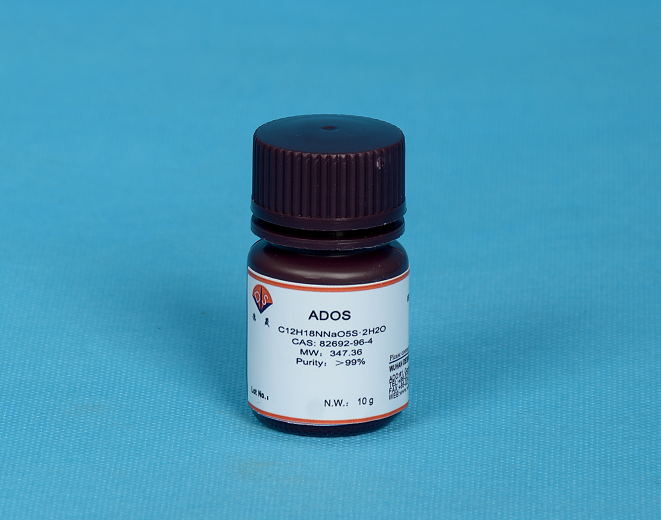Application and its detection method of New Triner's reagent ADOS
Release time:
2020-05-07
ADOS, the full name is N-ethyl-N- (2-hydroxy-3-sulfopropyl l) -3-methoxyaniline sodium salt (dihydrate), molecular weight 347.36035. This product has high water solubility and stable aniline analogues. It has a wide pH range for chromogenic development and oxidation reactions. The product is white crystalline powder with a storage temperature of 0-5℃. It needs to be placed in a dark and dry condition.

Picture of ADOS
Application of new Triner's reagent ADOS
The new Trinder ’s reagent is a highly water-soluble aniline derivative, which is widely used in diagnostic tests and biochemical tests. It has several advantages over conventional chromogenic reagents in the colorimetric determination of hydrogen peroxide activity. The new Trinder ’s reagent is stable enough to be used in both solutions and test line inspection systems.
In the presence of hydrogen peroxide and peroxidase, the new Trinder's reagent in the process of oxidative coupling with 4-aminoantipyrine (4-AA) or 3-methylbenzothiazole sulfone hydrazone (MBTH), forms a very stable purple or blue dye. The molar absorbance of the coupling dye with MBTH is 1.5-2 times higher than that with 4-AA; however, the 4-AA solution is more stable than the MBTH solution. The substrate is enzymatically oxidized by its oxidase to produce hydrogen peroxide. The concentration of hydrogen peroxide corresponds to the substrate concentration. Therefore, the amount of substrate can be determined by the chromogenic development of the oxidative coupling reaction. Glucose, alcohol, acyl-CoA and cholesterol can be used to detect those substrates coupled with the new Trinder ’s reagent and 4-AA. There are 10 kinds ofnew Trinder ’s reagents. However, for specific substrates, testing different types of new Trinder ’s reagents is necessary to develop the best detection system.
Detection method of new Triner's reagent ADOS
1. Prepare sample solution for enzymatic oxidation reaction. The pH value of the buffer solution should be 5.5-9.5.
2. Use the same buffer to prepare a standard solution containing a known amount of substrate.
3. Add the appropriate unit of oxidase to the sample solution, and then add an equal volume of detection solution.
4. Incubate the mixture at room temperature or 37℃ for 30 minutes to 1 hour.
5. Prepare a standard curve and determine the substrate concentration in the sample solution.
The ADOS produced by Desheng has a purity of more than 99%, good water solubility, and stable technology. This product needs to be placed in a dry and cool place for closed storage, and a container device with better protection from light should be used. Desheng has deep research on the new Trinder ’s reagent of chromogen substrate, and also provides products such as TOOS, TOPS, ADPS, ALPS, DAOS, HDAOS, MADB, MAOS, etc. If you have any requirements, please call +86 15071057538.
Next page
Next page
Contact details
Contact number
Address: C8, Guanggu United Science and Technology City, Ezhou City, Hubei Province
Fax:0711-3704 589
Follow us



